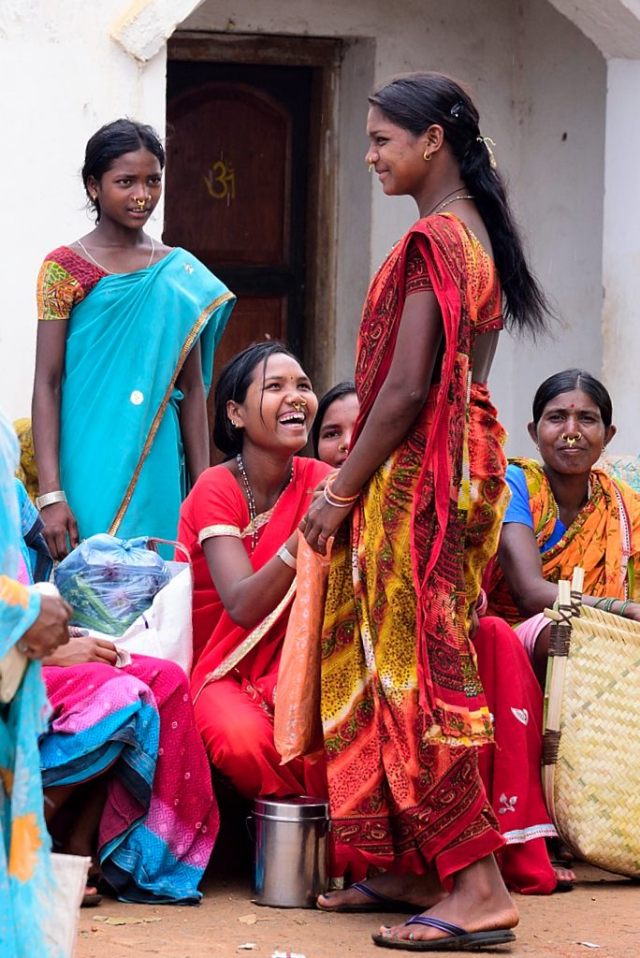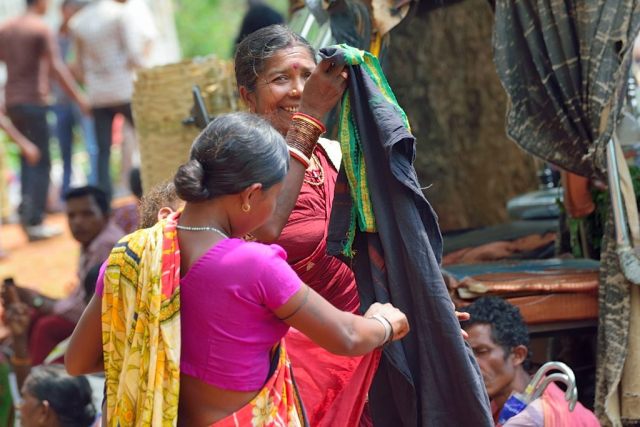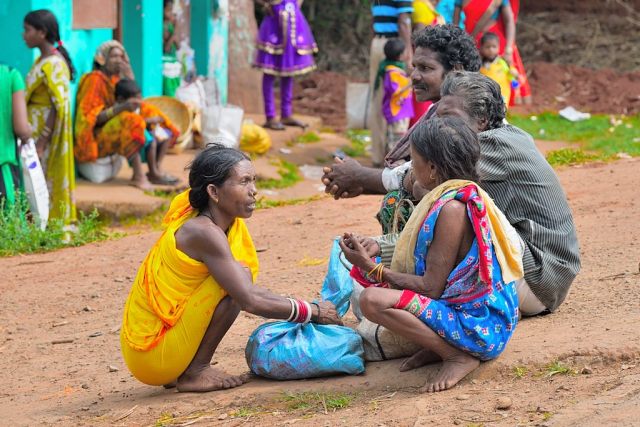On a visit to Orissa in search of the elusive Dongria Kondh tribe, I chanced upon a weekly market in a remote village called Kakriguma. I was curious about what a flea market in a village populated with mainly tribals would have on display. I knew it would be a difficult experience, what with the summer heat beating down in a place I had no previous experience or limited knowledge of. I was at once captivated by the ladies in their brightly colored sarees and bovine nose rings. The men were nowhere near the charm the ladies exude in these parts.

Perhaps it was her unintended sense of fashion or maybe the sheer ‘Africanness’ in the mood of the frame that drew me to this lady. It’s hard to judge a tribal from a non tribal especially in a terrain known for its political unrest.

The weekly market has a large chunk of tribals engaged in agriculture and fishing. There was a sense of contentment on this old lady’s face. Her personality apart, I loved the cheerful contrast offered by her magenta saree.

I was captivated by the tattoos on this lady’s feet. Women decorate themselves with a great sense of colour and style.

I’m not sure if this pretty woman represents the Dongria Kondh tribe. The nose rings and hand-woven saree seemed to suggest so. Much to my disappointment, there wasn’t a single vendor selling woven fabric or clothing.

This second generation of tribals prefers to wear blouses with their sarees most of which come in from Surat in Gujarat. Sadly, they seem to have given up the traditional blouseless drape so unique to this part of India. It classifies them as a backward class you see.

I was hoping to see some authentic tribal jewellery here. The beads seemed commonplace with hardly any copper, brass, or white metal jewellery I so strongly associated with this region. Locals prefer plastic unfortunately.

Turkish evil eye necklaces on display in this market! It seems to have replaced the original tribal symbols that I had come in search of. The bead necklaces are synonymous with the local culture here.

This picture proves my theory that ladies with blouses are economically better off than the ones without! Frankly I saw a higher sense of aesthetic in the poor woman in the foreground. So much more fashionable and sensible in the hot summer sun.

Dry fish is indigenous to Orissa. It’s salted and dried over 4 days ending up with a strong, cheesy odour. To the less hardy, the odour can be obnoxious in a market like this. The curry made from it with mustard is a delicacy is what I learnt.

Kakriguma has a famous pottery village nearby where tribals make every kind of earthenware for home use. Sadly, there were no takers for this lack lustre vendor. Most buyers these days prefer Aluminium pots to terracotta.

This was the seconds stall where a poor man was selling old worn sarees to even poorer folk. The lady was happy with her find.

The fast, the cheap, the easy and the fake have found their takers even in what was until recently a remote part of India. No matter where we live the cultural symbols of progress seem to be consumerism. Tobacco and soaps are best sellers here.

I was under the impression that barter was the way the weekly market functioned in this village. Nope, it was all about the money, honey! The new economy does not appreciate the idea of exchanging goods.

In case you thought this happened only in Thailand, on the spot tailoring is one of the features of this market too. Stitching blouses, shirts and bags at breakneck speed in the hot sun, that’s different.

The weekly market affords timeout with friends from neighbouring villages. The land has a history of Maoist attacks and dissent among tribals.









Beautiful captures, Shabnam…very vibrant and colourful. And thanks for following my blog, much appreciated 🙂
LikeLike
Great photos, I just remembered my sons’ photography workshop and he had taken pics of people randomly. I do support his passion though.
Simon
LikeLike
What a different world you live in from mine in the United States. I hope someday I’ll get to visit some parts of India.
LikeLike
I have no idea how this looks to an American, there are so many Indias this one is hidden somewhere inside in lesser known place…. wishing you whatever it takes to go wherever your heart desires 🙂 thanks for the visit
LikeLike
A fabulous gallery Shabnam. The traditional attire is certainly more beautiful…I wish it didn’t hold a ‘backward’ stigma.
LikeLike
thanks for taking a look, not many people go there
LikeLike
Beautiful captures! I feel like walking in the market with you. Their clothing and facial jewelry are very unique. Remarkable documentary!
LikeLike
Thank you Indah for your spontaneous response, am glad you liked it! These people are the unsung heros of our democracy
LikeLike
Beautiful photographs, Shabnam. Most of them being candid, give you a feeling of being ‘there’, in the midst of all that hustle and bustle!
LikeLike
Thanks Uday, I was a bit intimidated by the crowds milling around in the narrow aisles and felt I was unable to capture that particular sense of ‘crowdedness’ in long shots. Am glad you feel these portraits seem to convey the hustle and bustle!
LikeLike
Thanks for this beautiful and memorable window into your world. My best wishes to you 🙂
LikeLike
Thank you Andrew Seal, wishing you the same. I hope you will be back for part 2 & 3!!!!
LikeLike
You partrayed these women (and few men) so well, really feels like you´re sneaking into their daily lifes. Very well done! Greetings, Ron
LikeLike
Thank you Ron, its great to have you visit after a long long time, you are generous with your compliments when you like something so cheers to that!
LikeLike
You´re very welcome, my friend! Hope everything is going great, and I´ll be around 😉
Have a great weekend!
LikeLike
Those pictures are just awesome Shabnam!!! I lost track of time…looked at each one of them thrice..and was completely disappointed when I reached the end! Amazing work…more please 😛
LikeLike
Thank you Kuhu, I really had no idea these would be so popular! I have so many sometimes I worry if the repetition will become boring…. so good to hear your wonderful comment, makes me want to post the next series soon!
LikeLike
Hi Shabbat , along with these haats try the melas also , this is the season ,many local fairs in Rajasthan n Gujarat, Tarnetar near surrender nagar . Looking forward to more of ur photo stories . All the women in saris only brought back a big chunk of my early childhood in Calcutta . Thku ! Looking forward to more.
LikeLiked by 1 person
It’s always nice to see street photography from India. More please!
LikeLike
Thank you for your kind and courteous response, shal do so master!
LikeLike
Thanks Cardinal for your visit and demand for more, will do the best I can to find more interesting subjects! Fish maybe.
LikeLike
Such colours ,lov ,laughter ,n beauty can be captured by a lens in an artists hands
LikeLike
Whoever you are Anonymous, thank you for your wonderful words, I think Imight know you and love you!
LikeLike
India! that’s were I would love to go.. Beautiful pictures, lovely colors, hope to go soon.
LikeLike
There are so many Indias let me know before you plan your trip haha! and I hope to visit Morocco before I die though I know its the most photographed place after Italy!
LikeLike
I definitely will do that. Today I was busy all day preparing indian food, homemade samosa, homemade naan, something with kidney beans, butter paneer masala, aloo jeera, peanut chaat,.. we make indian food every day, since we are vegetarians, so you can image i am so keen on going to india. I also think the most beautiful picture are to be made in india, not morocco 🙂
LikeLike
wow, come right away, where did you learn to cook all this delicious food!!!! oh no Morocco is my dream!
LikeLike
Im so glad to have discovered your blog…ur clicks are just amazingly beautiful!
LikeLike
Thank you feeding the sonis!!! I love your name…. its wonderful to receive such encouraging comments from fellow bloggers, am so glad you saw the beauty in these people… 🙂
LikeLike
I believe that the hand loom sari that you admire is from Sambalpur, Orissa but saris like that one can be found at any Orissa handloom emporium. Also, the tailors that you show are most likely doing mending of worn out shirts and trousers. I have lived and worked in Orissa for many years designing and producing my own line of clothing there. I love Orissa, known as Odisha today. Sadly, the tribals are truly India’s most marginalized people. Thanks for this wonderful view into their lives.
LikeLike
Thank you ninagrandiose for your visit and informative comment, in a village like this its hard to find an emporium which is more a city urban thing, I thought I would meet the weavers selling their weaves in an authentic setting…. am glad you liked it
LikeLike
Great post! Thank you so much for taking us there.
LikeLike
My pleasure Amy, thanks for dropping by….
LikeLike
Beautiful ladies, beautiful faces. Very good photography.
LikeLike
Thank you Bente, you are kind and generous….
LikeLike
Fascinating photos, I’ve just been transported to a very different part of the world – beautiful and so colourful.
LikeLike
Thanks Helen briggs, am happy that the photographs managed to convey a sense of this place, alas i had no long shots as the faces drew me into the market rather than the tents under which all this was happenning….
LikeLike
Great coverage. Almost all parts of India I believe have weekly markets, going under the name ‘haat’. Hope you would continue to cover similar happenings in other areas as well.
LikeLike
Thanks Ashok for your visit and comment, I will try to document whatever i see but to cover similar haats in a country as vast as ours without commission seems unlikely! To tell you the truth it costs an arm and a leg!
LikeLike
Yes, I can guess so. Let us hope you will get commissioned by a well meaning organization in the not too distant a future. More power to your camera!
LikeLike
thank you for your kind wishes… have a great Monday!
LikeLike